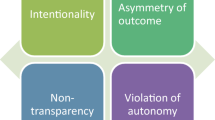Abstract
The paper argues that physical environments are relevant and at time critical elements of the cognitive activities of individual agents and communities, and this should become an important consideration in designing such environments. To this end, the concept of stigmergy can be instrumental to the evaluation and design of environments that facilitate cognitive and information processing activities of human individuals and communities. Stigmergy is here introduced both as an explanatory principle and as the operative mechanism by which structured environments can operate as mediums of shared knowledge and mediators of self-organizing processes of coordination among loosely coupled individuals. The arguments are supported by three case studies.
Similar content being viewed by others
References
T. Susi, T. Ziemke, Cogn. Syst. Res. 2, 273 (2001)
A. Ricci, A. Omicini, M. Viroli, L. Gardelli, E. Oliva, in Environ. Multi-Agent Syst. III (Springer, Berlin, Heidelberg, 2006), pp. 124–140
H. Van Dyke Parunak, in Environ. Multi-Agent Sysyt. II (Springer, Berlin, Heidelberg, 2006) pp. 163–186
J.F. Sallis, G. Karen, Futur. Child. 16, 89 (2006)
S. Wohl, Int. J. Islam. Archit. 4, 39 (2015)
K. Milun, Pathologies of Modern Space: Empty Space, Urban Anxiety, and the Recovery of the Public Self (Routledge, 2013)
L. Marsh, C. Onof, Cogn. Syst. Res. 9, 136 (2008)
J.S. Turner, Am. Entomol. 51, 1 (2005)
G. Theraulaz, E. Bonabeau, Artif. Life 5, 97 (1999)
F. Heylighen, Cogn. Syst. Res. 38, 4 (2016)
M. Rowlands, Ethics Environ. 10, 5 (2005)
F. Heylighen, Comput. Math. Organ. Theory 5, 253 (1999)
F. Heylighen, Cogn. Syst. Res. 38, 50 (2016)
M. Moussaid, S. Garnier, G. Theraulaz, D. Helbing, Top. Cogn. Sci. 1, 469 (2009)
D. Helbing, L. Buzna, A. Johansson, T. Werner, Transp. Sci. 39, 1 (2005)
P. Robbins, M. Aydede, The Cambridge Handbook of Situated Cognition (Cambridge University Press, 2009)
M. Wilson, Psychon. Bull. Rev. 9, 4 (2002)
P.M. Todd, G. Gigerenzer, Curr. Dir. Psychol. Sci. 16, 167 (2007)
F. Heylighen, Comput. Math. Organ. Theory 5, 3 (1999)
M. Elliott, Ph.D. thesis, Victorian College of the Arts, 2007
D. Levin, G.S. Borghini, S. Geiger, Z. Markfeld, in ECIS 2014 Proc. - 22nd Eur. Conf. Inf. Syst. (2014)
A.R. Hevner, Scand. J. Inf. Syst. 19, 87 (2007)
United Nations, Habitat III Issue Paper 22: Informal Settlements, 2015
C. Baley, Bedouin Law from Sinai and the Negev: Justice without Government (9780300153248): Clinton Bailey: Books (Yale University Press, 2009)
Y. Rosner Manor, G.S. Borghini, Y. Rofe’, Complex. Gov. Networks (to be published)
T. Fenster, Prog. Plann. 39, 167 (1993)
A.S. Reber, Implicit Learning: An Essay on the Cognitive Unconscious (Oxford University Press, 1993)
Y. Manor-Rosner, Y. Rofè, S. Abu-Rabia-Queder, in Vernac. Herit. Earthen Archit. (CRC Press, 2013), pp. 531–536
J. Gehl, B.B. Svarre, J. Risom, Plan. News 37, 6 (2011)
O. Avital, Speaker Notes, Holon Institute of Technology, 2015
M. Dorigo, E. Bonabeau, G. Theraulaz, Futur. Gener. Comput. Syst. 16, 851 (2000)
M. Levi, Speaker Notes, Holon Institute of Technology, 2015
F. Heylighen, Worldviews, Science and Us (World Scientific, Singapore, 2006)
J. Kendal, J.J. Tehrani, J. Odling-Smee, Philos. Trans. R. Soc. London B 366, 1566 (2011)
J. Odling-Smee, J.S. Turner, Biol. Theory 6, 283 (2011)
Author information
Authors and Affiliations
Corresponding author
Rights and permissions
About this article
Cite this article
Borghini, S.G. Stigmergy in the design of social environments. Eur. Phys. J. Spec. Top. 226, 269–281 (2017). https://doi.org/10.1140/epjst/e2016-60361-4
Received:
Revised:
Published:
Issue Date:
DOI: https://doi.org/10.1140/epjst/e2016-60361-4




